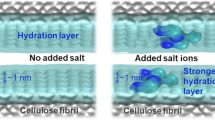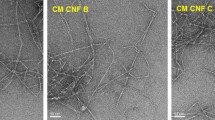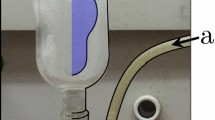Abstract
Carboxylated cellulose nanofibers (CNFs), having an average width of 7 nm and thickness of 1.5 nm, were produced by TEMPO (2,2,6,6-tetramethylpiperidine-1-oxyl radical)-mediated oxidation method. The fiber cross-sectional dimensions were determined using small-angle X-ray scattering (SAXS), transmission electron microscopy and atomic force microscopy techniques, where the rheological properties under different concentration and ionic strength were also investigated. The formation of hydrogel was evidenced by increasing the CNF concentration or ionic strength of the solvent (water), while the gel structure in ion-induced CNF hydrogels was found to be relatively inhomogeneous. The gelation behavior was closely related to the segmental aggregation of charged CNF, which could be quantitatively characterized by the correlation length (ξ) from the low-angle scattering profile and the scattering invariant (Q) in SAXS.









Similar content being viewed by others
References
Allaire M, Yang L (2011) Biomolecular solution X-ray scattering at the national synchrotron light source. J Synchrotron Radiat 18:41–44
Araki J (2013) Electrostatic or steric?—preparations and characterizations of well-dispersed systems containing rod-like nanowhiskers of crystalline polysaccharides. Soft Matter 9:4125
Boluk Y, Zhao LY, Incani V (2012) Dispersions of nanocrystalline cellulose in aqueous polymer solutions: structure formation of colloidal rods. Langmuir 28:6114–6123
Cherhal F, Cousin F, Capron I (2015) Influence of charge density and ionic strength on the aggregation process of cellulose nanocrystals in aqueous suspension, as revealed by small-angle neutron scattering. Langmuir 31:5596–5602
Cleuziou JP, Wernsdorfer W, Bouchiat V, Ondarcuhu T, Monthioux M (2006) Carbon nanotube superconducting quantum interference device. Nat Nanotechnol 1:53–59
Cohen Y, Ramon O, Kopelman IJ, Mizrahi S (1992) Characterization of inhomogeneous polyacrylamide hydrogels. J Polym Sci Part B Polym Phys 30:1055–1067
Debye P, Anderson HR, Brumberger H (1957) Scattering by an inhomogeneous solid. 2. The correlation function and its application. J Appl Phys 28:679–683
Dong H, Snyder JF, Williams KS, Andzelm JW (2013) Cation-induced hydrogels of cellulose nanofibrils with tunable moduli. Biomacromolecules 14:3338–3345
Dugan JM, Gough JE, Eichhorn SJ (2013) Bacterial cellulose scaffolds and cellulose nanowhiskers for tissue engineering. Nanomedicine 8:287–298
Fall AB, Lindstrom SB, Sundman O, Odberg L, Wagberg L (2011) Colloidal stability of aqueous nanofibrillated cellulose dispersions. Langmuir 27:11332–11338
Fall AB, Lindström SB, Sprakel J, Wågberg L (2013) A physical cross-linking process of cellulose nanofibril gels with shear-controlled fibril orientation. Soft Matter 9:1852–1863
Fukuzumi H, Saito T, Wata T, Kumamoto Y, Isogai A (2009) Transparent and high gas barrier films of cellulose nanofibers prepared by TEMPO-mediated oxidation. Biomacromolecules 10:162–165
Fukuzumi H, Tanaka R, Saito T, Isogai A (2014) Dispersion stability and aggregation behavior of TEMPO-oxidized cellulose nanofibrils in water as a function of salt addition. Cellulose 21:1553–1559
Gaboriaud F, Nonat A, Chaumont D, Craievich A (1999) Aggregation and gel formation in basic silico-calco-alkaline solutions studied: a SAXS, SANS, and ELS study. J Phys Chem B 103:5775–5781
Glatter O, Kratky O (1982) Small angle X-ray scattering. Academic press, Cambridge
Habibi Y, Chanzy H, Vignon MR (2006) TEMPO-mediated surface oxidation of cellulose whiskers. Cellulose 13:679–687
Hakansson KMO, Fall AB, Lundell F, Yu S, Krywka C, Roth SV, Santoro G, Kvick M, Wittberg LP, Wagberg L, Soderberg LD (2014) Hydrodynamic alignment and assembly of nanofibrils resulting in strong cellulose filaments. Nat Commun 5:1–10
Heinze T, Liebert T, Klufers P, Meister F (1999) Carboxymethylation of cellulose in unconventional media. Cellulose 6:153–165
Hexemer A, Bras W, Glossinger J, Schaible E, Gann E, Kirian R, MacDowell A, Church M, Rude B, Padmore H (2010) A SAXS/WAXS/GISAXS beamline with multilayer monochromator. J Phys Conf Ser 247:1–11
Ho TTT, Zimmermann T, Hauert R, Caseri W (2011) Preparation and characterization of cationic nanofibrillated cellulose from etherification and high-shear disintegration processes. Cellulose 18:1391–1406
Ilavsky J (2012) Nika: software for two-dimensional data reduction. J Appl Crystallogr 45:324–328
Isogai A, Saito T, Fukuzumi H (2011) TEMPO-oxidized cellulose nanofibers. Nanoscale 3:71–85
Jowkarderis L, van de Ven TM (2014) Intrinsic viscosity of aqueous suspensions of cellulose nanofibrils. Cellulose 21:2511–2517
Ma H, Burger C, Hsiao BS, Chu B (2011) Ultrafine polysaccharide nanofibrous membranes for water purification. Biomacromolecules 12:970–976
Ma H, Burger C, Hsiao BS, Chu B (2014) Fabrication and characterization of cellulose nanofiber based thin-film nanofibrous composite membranes. J Membr Sci 454:272–282
Mao YM, Liu K, Zhan CB, Geng LH, Chu B, Hsiao BS (2017) Characterization of nanocellulose using small-angle neutron, X-ray, and dynamic light scattering techniques. J Phys Chem B 121:1340–1351
Naderi A, Lindström T, Pettersson T (2014a) The state of carboxymethylated nanofibrils after homogenization-aided dilution from concentrated suspensions: a rheological perspective. Cellulose 21:2357–2368
Naderi A, Lindström T, Sundström J (2014b) Carboxymethylated nanofibrillated cellulose: rheological studies. Cellulose 21:1561–1571
Naderi A, Lindström T, Sundström J, Pettersson T, Flodberg G, Erlandsson J (2015) Microfluidized carboxymethyl cellulose modified pulp: a nanofibrillated cellulose system with some attractive properties. Cellulose 22:1159–1173
Naderi A, Lindstrom T, Weise CF, Flodberg G, Sundstrom J, Junel K, Erlandsson J, Runebjork A (2016) Phosphorylated nanofibrillated cellulose: production and properties. Nord Pulp Pap Res J 31:20–29
Nishiyama Y, Langan P, Chanzy H (2002) Crystal structure and hydrogen-bonding system in cellulose 1 beta from synchrotron X-ray and neutron fiber diffraction. J Am Chem Soc 124:9074–9082
Nishiyama Y, Sugiyama J, Chanzy H, Langan P (2003) Crystal structure and hydrogen bonding system in cellulose 1(alpha), from synchrotron X-ray and neutron fiber diffraction. J Am Chem Soc 125:14300–14306
Nishiyama Y, Johnson GP, French AD, Forsyth VT, Langan P (2008) Neutron crystallography, molecular dynamics, and quantum mechanics studies of the nature of hydrogen bonding in cellulose I-beta. Biomacromolecules 9:3133–3140
Okita Y, Saito T, Isogai A (2010) Entire surface oxidation of various cellulose microfibrils by TEMPO-mediated oxidation. Biomacromolecules 11:1696–1700
Pei AH, Butchosa N, Berglund LA, Zhou Q (2013) Surface quaternized cellulose nanofibrils with high water absorbency and adsorption capacity for anionic dyes. Soft Matter 9:2047–2055
Perez DD, Montanari S, Vignon MR (2003) TEMPO-mediated oxidation of cellulose III. Biomacromolecules 4:1417–1425
Saito T, Nishiyama Y, Putaux JL, Vignon M, Isogai A (2006) Homogeneous suspensions of individualized microfibrils from TEMPO-catalyzed oxidation of native cellulose. Biomacromolecules 7:1687–1691
Saito T, Kimura S, Nishiyama Y, Isogai A (2007) Cellulose nanofibers prepared by TEMPO-mediated oxidation of native cellulose. Biomacromolecules 8:2485–2491
Saito T, Uematsu T, Kimura S, Enomae T, Isogai A (2011) Self-aligned integration of native cellulose nanofibrils towards producing diverse bulk materials. Soft Matter 7:8804–8809
Samir MASA, Alloin F, Dufresne A (2005) Review of recent research into cellulosic whiskers, their properties and their application in nanocomposite field. Biomacromolecules 6:612–626
Sirvio JA, Kolehmainen A, Visanko M, Liimatainen H, Niinimaki J, Hormi OEO (2014) Strong, self-standing oxygen barrier films from nanocelluloses modified with regioselective oxidative treatments. ACS Appl Mater Interfaces 6:14384–14390
Su Y, Burger C, Hsiao BS, Chu B (2014) Characterization of TEMPO-oxidized cellulose nanofibers in aqueous suspension by small-angle X-ray scattering. J Appl Crystallogr 47:788–798
Su Y, Burger C, Ma H, Chu B, Hsiao BS (2015) Exploring the nature of cellulose microfibrils. Biomacromolecules 16:1201–1209
Tanaka R, Saito T, Ishii D, Isogai A (2014) Determination of nanocellulose fibril length by shear viscosity measurement. Cellulose 21:1581–1589
Tatsumi D, Ishioka S, Matsumoto T (2002) Effect of fiber concentration and axial ratio on the rheological properties of cellulose fiber suspensions. J Soc Rheol Jpn 30:27–32
Uhlig M, Fall A, Wellert S, Lehmann M, Prevost S, Wagberg L, von Klitzing R, Nystrom G (2016) Two-dimensional aggregation and semidilute ordering in cellulose nanocrystals. Langmuir 32:442–450
Xiao JP, Pan XL, Zhang F, Li HB, Bao XH (2017) Size-dependence of carbon nanotube confinement in catalysis. Chem Sci 8:278–283
Xu XZ, Liu F, Jiang L, Zhu JY, Haagenson D, Wiesenborn DP (2013) Cellulose nanocrystals vs. cellulose nanofibrils: a comparative study on their microstructures and effects as polymer reinforcing agents. ACS Appl Mater Interfaces 5:2999–3009
Xu W, Chen Y, Zhan H, Wang JN (2016) High-strength carbon nanotube film from improving alignment and densification. Nano Lett 16:946–952
Zhang S, Deng H, Zhang Q, Fu Q (2014) Formation of conductive networks with both segregated and double-percolated characteristic in conductive polymer composites with balanced properties. ACS Appl Mater Interfaces 6:6835–6844
Acknowledgments
The authors would like to thank the SusChEM Program of National Science Foundation (DMR-1409507) for the financial support. The authors acknowledge the technical support of the 7.3.3 beamline in ALS, LBNL and the NG7-30 m beamline in NCNR, NIST. The authors would also like to thank Dr. Dufei Fang, Stony Brook University, for composing the ribbon model program using the software of SASView, originally developed under the NSF award DMR-0520547. In addition, L.G. would like to thank the Chinese Scholarship Council for the financial support of his overseas study in the U.S. and A.N. would like to thank the Gunnar Sundblad Foundation for supporting his study at Stony Brook University.
Product Disclaimer
The identification of any commercial product or trade name does not imply endorsement or recommendation by the National Institute of Standards and Technology.
Author information
Authors and Affiliations
Corresponding authors
Electronic supplementary material
Below is the link to the electronic supplementary material.
10570_2017_1496_MOESM1_ESM.docx
Supplementary material 1 (DOCX 82 kb) Notes Product Disclaimer: The identification of any commercial product or trade name does not imply endorsement or recommendation by the National Institute of Standards and Technology
Rights and permissions
About this article
Cite this article
Geng, L., Peng, X., Zhan, C. et al. Structure characterization of cellulose nanofiber hydrogel as functions of concentration and ionic strength. Cellulose 24, 5417–5429 (2017). https://doi.org/10.1007/s10570-017-1496-2
Received:
Accepted:
Published:
Issue Date:
DOI: https://doi.org/10.1007/s10570-017-1496-2




